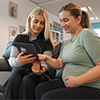Feeling your baby move for the first time is one of the most exciting milestones during pregnancy. Those little kicks and wriggles are a reassurance that your baby is growing and developing. However, there may be times when you’re eager to feel more movement, or you may be concerned about the frequency of movements. In this blog post, we’ll explore several ways to encourage your baby to move in the womb, as well as discuss when to seek medical advice.
When Do You First Feel Baby Movements?
The first movements, often described as “quickening,” typically occur between 18 and 25 weeks of pregnancy. For first-time mums, it might be later in the second trimester, while those who’ve been pregnant before may notice these movements earlier. These early flutters can feel like gentle taps, bubbles, or even like something is “fluttering” inside you.
As your pregnancy progresses, the movements become more distinct, and by the third trimester, you’ll likely feel regular kicks, rolls, and even hiccups. However, it’s important to note that some babies are more active than others, so the frequency of movements can vary.
Ways to Encourage Baby Movements
If you’re finding that your baby is particularly quiet or you’re simply eager to feel those reassuring movements, here are a few techniques that might help stimulate activity:
1. Lie Down and Relax
One of the simplest ways to encourage your baby to move is to lie down on your left side, in a quiet and relaxed environment. Lying on your left side increases blood flow to the placenta, which can stimulate your baby’s movements. Make sure you’re in a comfortable position, as stress and discomfort can make you less likely to notice any movements.
2. Eat or Drink Something Cold
Babies tend to become more active after you eat or drink, especially if what you’ve consumed is a bit cold or sweet. Cold drinks, such as a glass of iced water or cold juice, may get your baby moving. Sweet treats like chocolate or sugary snacks can also prompt a response as your baby may react to the change in your blood sugar levels. Always listen to your body and ensure you maintain a balanced diet for you and your baby’s health.
3. Play Music or Talk to Your Baby
Babies can hear sounds from outside the womb by around 25 weeks, so playing soft music or speaking to your baby can sometimes prompt a response. Some mums swear by talking or singing to their little one to get a little kick back. Your voice is familiar to your baby and can bring a sense of calm or curiosity.
4. Gentle Tapping
You can try gently tapping or rubbing your belly. Lightly patting the side of your tummy may provoke movement, as it can cause a slight vibration that may get your baby’s attention. It’s a low-pressure method, so don’t be too forceful. If your baby is awake, they may respond with a gentle nudge or kick.
5. Change Positions
Sometimes, the baby might simply be in a position that makes it hard for you to feel their movements. Changing your position can help. For example, if you’ve been sitting for a while, try standing up or walking around. Alternatively, kneel on all fours for a few minutes, which may encourage your baby to shift position, potentially leading to more noticeable movements.
6. Drinking Water
Dehydration can sometimes cause a reduction in fetal movement. If you haven’t drunk much water, try sipping a glass of water slowly. Staying hydrated is important not only for your health but for your baby’s comfort too. Hydration ensures better amniotic fluid levels, which support your baby’s movements.
When to Worry About Lack of Movement
Most babies will establish a consistent pattern of movement by 28 weeks. If you notice a sudden decrease in movements or if you’re unable to feel your baby move for several hours, it’s important to seek medical advice immediately.
A reduction in movement could be a sign of several things, including an issue with the placenta or a medical condition. However, it’s always best to trust your instincts—if you feel something isn’t right, call your midwife or visit your doctor. They may advise you to come in for monitoring to ensure everything is okay.
Tips for Tracking Movements
From around 28 weeks of pregnancy, you might be asked to track your baby’s movements as part of your routine care. This can help you become more aware of any patterns and detect any changes in activity. Here’s how you can monitor your baby’s movements:
- Choose a time when you’re relaxed: It’s easier to notice movements when you’re calm and at ease, rather than when you’re distracted or busy.
- Count the kicks: Your healthcare provider may suggest counting the number of kicks or movements in an hour. If you don’t feel ten movements in an hour, it’s worth reaching out to your doctor.
- Note the pattern: Some babies are naturally more active in the evening, while others may be more active during the day. Tracking patterns can help you identify when your baby is typically most active.
Kicks Count: What They Are and Why They Matter
Kicks Count is an important way for pregnant women to monitor their baby’s movements and ensure everything is progressing well. From around 28 weeks of pregnancy, many healthcare providers recommend that you track your baby’s movements to become familiar with their unique pattern. This can help you notice any sudden changes, as a reduction in movement may indicate potential concerns. To track kicks, choose a quiet time each day to focus on your baby’s movements. Ideally, you should feel at least 10 movements within two hours. If you don’t, or if you notice a significant change in your baby’s normal activity, it’s important to contact your doctor or midwife to ensure everything is okay. Regular monitoring of movements gives both you and your healthcare team valuable insight into your baby’s well-being and can provide peace of mind.













 Packages & Prices
Packages & Prices  Important Info & Policies
Important Info & Policies  Your Scan
Your Scan